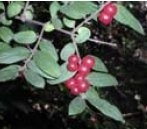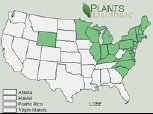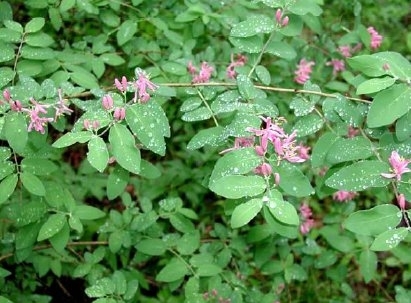Bell’s Honeysuckle
Contents
Bell’s Honeysuckle
Lonicera ×bella Zabel × tatarica
This article was produced by the USDA Forest Service, Forest Health Staff, Newtown Square, PA. WOW 04-17-06. Invasive Plants Website.
Common Names
Bell's honeysuckle, Bella honeysuckle, pretty honeysuckle, showy bush honeysuckle
Native Origin
Eurasia; deliberate hybridizations of this plant were made in Russia before 1889.
Description
 Bell’s honeysuckle is the hybrid of Morrow’s honeysuckle (Lonicera morrowii) and Tartarian honeysuckle (Lonicera tartarica), making identification difficult. It is an upright deciduous shrub in the Honeysuckle family (Caprifoliaceae), reaching a height to 20 feet. Stems are hollow and are sparsely pubescent. The leaves are opposite, oblong or oval in shape, slightly hairy, and 1 - 2.5 inches long. The flowers vary but are usually pink, fading to yellow, hairy, 0.2 to 0.6 inches long and appear in May to early June. The berries are spherical, red in color and found in pairs. The fruit ripen in late summer or early fall. The seeds are rather flat and ovate in shape. Seeds are often dispersed by birds.
Bell’s honeysuckle is the hybrid of Morrow’s honeysuckle (Lonicera morrowii) and Tartarian honeysuckle (Lonicera tartarica), making identification difficult. It is an upright deciduous shrub in the Honeysuckle family (Caprifoliaceae), reaching a height to 20 feet. Stems are hollow and are sparsely pubescent. The leaves are opposite, oblong or oval in shape, slightly hairy, and 1 - 2.5 inches long. The flowers vary but are usually pink, fading to yellow, hairy, 0.2 to 0.6 inches long and appear in May to early June. The berries are spherical, red in color and found in pairs. The fruit ripen in late summer or early fall. The seeds are rather flat and ovate in shape. Seeds are often dispersed by birds.
Habitat
Adapted to a variety of habitats, it thrives in sunny sites including open forests, forest edges, roadsides, pastures abandoned fields, fens, bogs, and lakeshores. It is relatively shade intolerant.
Distribution
 This species is reported from states shaded on Plants Database map. It is reported invasive in CT, IL, MD, ME, MI, NC, NH, NY, PA, RI, TN, VA, VT, and WI.
This species is reported from states shaded on Plants Database map. It is reported invasive in CT, IL, MD, ME, MI, NC, NH, NY, PA, RI, TN, VA, VT, and WI.
Ecological Impacts
Some infestations have spread from horticultural plantings, wildlife habitat improvement plantings and erosion control plantings. This plant’s vigorous growth and early spring leaf-out inhibit growth of native shrubs and ground layer species reducing wildlife food and cover. It reduces the richness and cover of herb communities and delays establishment of new seedlings. If not controlled, plants can become massive in size and eventually replacing native plants by crowding out, shading, and depleting soil of moisture and nutrients.
Control and Management
Control methods should be repeated for 3 to 5 years to deplete seedbank.
- Manual - Cut or dig out when soil is moist; remove all shallow roots; and
- Chemical - It can be effectively controlled using any of several readily available general use herbicides such as glyphosate or triclopyr. Follow label and state requirements.
Note
- Additional information and fact sheets on exotic honeysuckles (Amur, Marrow’s Tartarian) can be found at http://na.fs.fed.us/fhp/invasive_plants/weeds/index.shtm .
References
- http://plants.usda.gov, www.nps.gov/plants/alien ,
- http://webapps.lib.uconn.edu/ipane/browsing.cfm?descriptionid=69 ; and
- Czarapata, Elizabeth J., Invasive Plants of the Upper Midwest, An Illustrated Guide to their Identification and Control, 2005. P. 32-35
